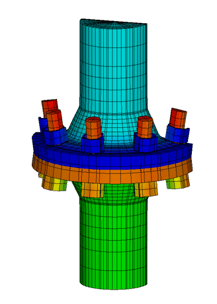FEA for Flange Design & Analysis
Easily Prevent Leaks with FlangePRO
Experience Leak Prevention Technology
FlangePRO is an advanced FEA program designed to quickly analyze axisymmetric and brick element models, identifying stresses in flange joints. It can evaluate both standardized and custom designs, and offers predictions for leaks and emissions while simplifying the process of design compliance across a variety of codes and standards.


| Flange Design & Analysis Simplified | ||
|---|---|---|
| Feature | Capability | Use |
| Automatic FEA | Provides an automatic FEA analysis of standardized or custom axisymmetric models and brick models of flanged joints. | Allows users to visualize stresses and rotations on the model for API, ASME B16.5, ASME B16.47, or DIN. Users can also visualize allowable external forces, moments, or torsional loads on the flange joints they're designing. |
| Design Validation for Global Codes | Provides design checks for ASME Section VIII, Div 2, ASME Appendix 2, ASME BFJ, and EN 13445 Annex G. | Allows users to check their design against a variety of codes while also comparing the FEA results to the code calculations for the same geometries. Gasket properties for each of these standards are stored in the program's database. They can be loaded directly onto the model and modified to fit the user's needs. |
| Leak Prediction | Predicts for leakage and emission. |
Users can prevent leaks in joints that are generally caused by pressure, external loads, loose bolts, or unsatisfactory gasket seating. |
| Gasket Modeling Options | Supports linear and nonlinear stiffness models, including a nonlinear approach similar to the PVRC method for accurately assessing gasket stress under varying conditions. |
The program supports Ring Type Joints (RTJs), which plastically deform under axial compressive loads, filling irregularities in the flange groove. They have high surface stresses due to a small load-bearing area and poor recovery characteristics, requiring a proper axial load for sealing. Given the confusion regarding bolt allowable stresses between ASME Section II Part D and PCC-1, the program analyzes the bolt load distribution. PCC-1 permits higher preload capacities (40-70% of ambient yield strength), while ASME focuses on applied load considerations, especially in non-flange applications where shear and bending moments may occur. |
| Gap Surfaces | Accounts for gap tolerances and computes gap closures in handling flat-faced or raised-face geometries. |
Users can easily account for gaps due to bolt-up conditions in the model. |
| Thermal Modeling | Performs steady state or transient thermal analyses for both operating and cool down conditions. | Users can account for the maintenance of the flange as it relates to the entire system. |
| Flange Design & Analysis Simplified | |
|---|---|
| Feature | Capability |
| Use | |
| Automatic FEA | Provides an automatic FEA analysis of standardized or custom axisymmetric models and brick models of flanged joints. |
Allows users to visualize stresses and rotations on the model for API, ASME B16.5, ASME B16.47, or DIN. Users can also visualize allowable external forces, moments, or torsional loads on the flange joints they're designing. |
|
| Design Validation for Global Codes | Provides design checks for ASME Section VIII, Div 2, ASME Appendix 2, ASME BFJ, and EN 13445 Annex G. |
Allows users to check their design against a variety of codes while also comparing the FEA results to the code calculations for the same geometries. Gasket properties for each of these standards are stored in the program's database. They can be loaded directly onto the model and modified to fit the user's needs. |
|
| Leak Prediction | Predicts for leakage and emission. |
| Users can prevent leaks in joints that are generally caused by pressure, external loads, loose bolts, or unsatisfactory gasket seating. | |
| Gasket Modeling Options | Supports linear and nonlinear stiffness models, including a nonlinear approach similar to the PVRC method for accurately assessing gasket stress under varying conditions. |
The program supports Ring Type Joints (RTJs), which plastically deform under axial compressive loads, filling irregularities in the flange groove. They have high surface stresses due to a small load-bearing area and poor recovery characteristics, requiring a proper axial load for sealing. Given the confusion regarding bolt allowable stresses between ASME Section II Part D and PCC-1, the program analyzes the bolt load distribution. PCC-1 permits higher preload capacities (40-70% of ambient yield strength), while ASME focuses on applied load considerations, especially in non-flange applications where shear and bending moments may occur. |
|
| Gap Surfaces | Accounts for gap tolerances and computes gap closures in handling flat-faced or raised-face geometries. |
| Users can easily account for gaps due to bolt-up conditions in the model. | |
| Thermal Modeling | Performs steady state or transient thermal analyses for both operating and cool down conditions. |
| Users can account for the maintenance of the flange as it relates to the entire system. | |
Schedule a call or demo today
To get started, fill out the form below, or give us a call at 281-920-9775.

